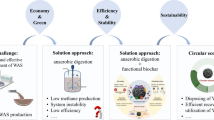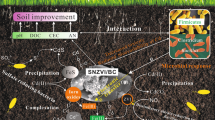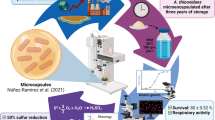Abstract
Low methane production and high levels of heavy metal in pig slurries limit the feasibility of anaerobic digestion of pig manure. In this study, changes in the methane production and bioavailability of heavy metals in the anaerobic digestion of diluted pig manure were evaluated using single and combined action of microscale zero-valence iron (ZVI) and magnetite. After 30 days of anaerobic digestion, the methane yield ranged from 246.9 to 334.5 mL/g VS added, which increased by 20–26% in the group added with microscale ZVI and/or magnetite relative to that in the control group. Results of the first-order kinetic model revealed that addition of microscale ZVI and/or magnetite increased the biogas production potential, rather than the biogas production rate constant. These treatments also changed the distribution of chemical fractions for heavy metal. The addition of ZVI decreased the bioavailability of Cu and Zn in the solid digested residues. Moreover, a better performance was observed in the combined action of microscale ZVI and magnetite, and the ZVI anaerobic corrosion end-product, magnetite, might help enhance methane production through direct interspecies electron transfer in ZVI-anaerobic digestion process.




Similar content being viewed by others
References
Abdelsalam E, Samer M, Attia Y, Abdel-Hadi M, Hassan H, Badr Y (2016) Comparison of nanoparticles effects on biogas and methane production from anaerobic digestion of cattle dung slurry. Renew Energy 87:592–598
APHA A WEF (1995) Standard methods for the examination of water and wastewater 19th ed Washington, DC: American Public Health Association
Aulenta F, Fazi S, Majone M, Rossetti S (2014) Electrically conductive magnetite particles enhance the kinetics and steer the composition of anaerobic TCE-dechlorinating cultures. Process Biochem 49:2235–2240
Björnsson L, Murto M, Jantsch TG, Mattiasson B (2001) Evaluation of new methods for the monitoring of alkalinity, dissolved hydrogen and the microbial community in anaerobic digestion. Water Res 35:2833–2840
Bolan N, Adriano D, Mahimairaja S (2004) Distribution and bioavailability of trace elements in livestock and poultry manure by-products. Crit Rev Environ Sci Technol 34:291–338
Bonmati A, Flotats X, Mateu L, Campos E (2001) Study of thermal hydrolysis as a pretreatment to mesophilic anaerobic digestion of pig slurry. Water Sci Technol 44:109–116
Chen Y, Hashimoto A Kinetics of methane fermentation. In: Biotechnol. bioeng. symp.;(United States), 1978. Dept. of Agriculture, Clay Center, NE
Cruz Viggi C, Rossetti S, Fazi S, Paiano P, Majone M, Aulenta F (2014) Magnetite particles triggering a faster and more robust syntrophic pathway of methanogenic propionate degradation. Environ Sci Technol 48:7536–7543
Dąbrowska L, Rosińska A (2012) Change of PCBs and forms of heavy metals in sewage sludge during thermophilic anaerobic digestion. Chemosphere 88:168–173
Daniels L, Belay N, Rajagopal BS, Weimer PJ (1987) Bacterial methanogenesis and growth from CO2 with elemental iron as the sole source of electrons. Science 237:509–511
Dong B, Liu X, Dai L, Dai X (2013) Changes of heavy metal speciation during high-solid anaerobic digestion of sewage sludge. Bioresour Technol 131:152–158
Donner E et al (2012) A multi-technique investigation of copper and zinc distribution, speciation and potential bioavailability in biosolids. Environ Pollut 166:57–64
Donner E, Brunetti G, Zarcinas B, Harris P, Tavakkoli E, Naidu R, Lombi E (2013) Effects of chemical amendments on the lability and speciation of metals in anaerobically digested biosolids. Environ Sci Technol 47:11157–11165
Feng Y, Zhang Y, Quan X, Chen S (2014) Enhanced anaerobic digestion of waste activated sludge digestion by the addition of zero valent iron. Water Res 52:242–250
Ferreira L, Souza T, Fdz-Polanco F, Pérez-Elvira S (2014) Thermal steam explosion pretreatment to enhance anaerobic biodegradability of the solid fraction of pig manure. Bioresour Technol 152:393–398
Fu F, Dionysiou DD, Liu H (2014) The use of zero-valent iron for groundwater remediation and wastewater treatment: a review. J Hazard Mater 267:194–205
Gacitua MA, González B, Majone M, Aulenta F (2014) Boosting the electrocatalytic activity of Desulfovibrio paquesii biocathodes with magnetite nanoparticles. International Journal of Hydrogen Energy 39:14540–14545
He MM, Tian GM, Liang XQ (2009) Phytotoxicity and speciation of copper, zinc and lead during the aerobic composting of sewage sludge. J Hazard Mater 163:671–677
Hsu J-H, Lo S-L (2000) Characterization and extractability of copper, manganese, and zinc in swine manure composts. J Environ Qual 29:447–453
** H, Chang Z (2011) Distribution of heavy metal contents and chemical fractions in anaerobically digested manure slurry. Appl Biochem Biotechnol 164:268–282
Karri S, Sierra-Alvarez R, Field JA (2005) Zero valent iron as an electron-donor for methanogenesis and sulfate reduction in anaerobic sludge. Biotechnol Bioeng 92:810–819
Kato S, Hashimoto K, Watanabe K (2012a) Methanogenesis facilitated by electric syntrophy via (semi) conductive iron-oxide minerals. Environ Microbiol 14:1646–1654
Kato S, Hashimoto K, Watanabe K (2012b) Microbial interspecies electron transfer via electric currents through conductive minerals. Proc Natl Acad Sci 109:10042–10046
Kong X, Wei Y, Xu S, Liu J, Li H, Liu Y, Yu S (2016) Inhibiting excessive acidification using zero-valent iron in anaerobic digestion of food waste at high organic load rates. Bioresour Technol 211:65–71
Li H, Chang J, Liu P, Fu L, Ding D, Lu Y (2015) Direct interspecies electron transfer accelerates syntrophic oxidation of butyrate in paddy soil enrichments. Environ Microbiol 17:1533–1547
Liang YG, Yin SS, Si YB, Zheng Z, Yuan SJ, Nie E, Luo XZ (2014) Effect of pretreatment and total solid content on thermophilic dry anaerobic digestion of Spartina alterniflora. Chem Eng J 237:209–216
Liang YG, Cheng B, Si YB, Cao DJ, Li DL, Chen JF (2016) Effect of solid-state NaOH pretreatment on methane production from thermophilic semi-dry anaerobic digestion of rose stalk. Water Sci Technol 73:2913–2920
Liu Y, Ma L, Li Y, Zheng L (2007) Evolution of heavy metal speciation during the aerobic composting process of sewage sludge. Chemosphere 67:1025–1032
Liu F, Rotaru AE, Shrestha PM, Malvankar NS, Nevin KP, Lovley DR (2015a) Magnetite compensates for the lack of a pilin-associated c-type cytochrome in extracellular electron exchange. Environ Microbiol 17:648–655
Liu Y, Wang Q, Zhang Y, Ni B-J (2015b) Zero valent iron significantly enhances methane production from waste activated sludge by improving biochemical methane potential rather than hydrolysis rate. Scientific Reports 5:8263
Marcato C-E, Pinelli E, Cecchi M, Winterton P, Guiresse M (2009) Bioavailability of Cu and Zn in raw and anaerobically digested pig slurry. Ecotoxicol Environ Saf 72:1538–1544
Moore P, Daniel T, Gilmour J, Shreve B, Edwards D, Wood B (1998) Decreasing metal runoff from poultry litter with aluminum sulfate. J Environ Qual 27:92–99
Perez-Gonzalez T, Jimenez-Lopez C, Neal AL, Rull-Perez F, Rodriguez-Navarro A, Fernandez-Vivas A, Iañez-Pareja E (2010) Magnetite biomineralization induced by Shewanella oneidensis. Geochim Cosmochim Acta 74:967–979
Rajagopal R, Massé DI, Singh G (2013) A critical review on inhibition of anaerobic digestion process by excess ammonia. Bioresour Technol 143:632–641
Ruhl AS, Franz G, Gernert U, Jekel M (2014) Corrosion product and precipitate distribution in two-component Fe(0) permeable reactive barriers. Chem Eng J 239:26–32
Siegert I, Banks C (2005) The effect of volatile fatty acid additions on the anaerobic digestion of cellulose and glucose in batch reactors. Process Biochem 40:3412–3418
Suanon F, Sun Q, Mama D, Li J, Dimon B, Yu C-P (2016) Effect of nanoscale zero-valent iron and magnetite (Fe3O4) on the fate of metals during anaerobic digestion of sludge. Water Res 88:897–903
Tessier A, Campbell PG, Bisson M (1979) Sequential extraction procedure for the speciation of particulate trace metals. Anal Chem 51:844–851
Wu D, Zheng S, Ding A, Sun G, Yang M (2015) Performance of a zero valent iron-based anaerobic system in swine wastewater treatment. J Hazard Mater 286:1–6
**ao X, Sheng GP, Mu Y, Yu HQ (2013) A modeling approach to describe ZVI-based anaerobic system. Water Res 47:6007–6013
Yamada C, Kato S, Ueno Y, Ishii M, Igarashi Y (2015) Conductive iron oxides accelerate thermophilic methanogenesis from acetate and propionate. J Biosci Bioeng 119:678–682
Zhang W, Lang Q, Wu S, Li W, Bah H, Dong R (2014) Anaerobic digestion characteristics of pig manures depending on various growth stages and initial substrate concentrations in a scaled pig farm in southern China. Bioresour Technol 156:63–69
Zhen G, Lu X, Li Y-Y, Liu Y, Zhao Y (2015) Influence of zero valent scrap iron (ZVSI) supply on methane production from waste activated sludge. Chem Eng J 263:461–470
Zhu L, Gao K, ** J, Lin H, Xu X (2014) Analysis of ZVI corrosion products and their functions in the combined ZVI and anaerobic sludge system. Environ Sci Pollut Res 21:12747–12756
Acknowledgments
This work was partly supported by National Key Technology Support Program (2012BAD14B13), Anhui Provincial Natural Science Foundation (1508085SMB210), and the open project of Key Laboratory of energy saving and waste disposal of protected agriculture of Ministry of Agriculture (ECWM-2017KT-01).
Author information
Authors and Affiliations
Corresponding authors
Additional information
Responsible editor: Philippe Garrigues
Rights and permissions
About this article
Cite this article
Liang, Yg., Li, Xj., Zhang, J. et al. Effect of microscale ZVI/magnetite on methane production and bioavailability of heavy metals during anaerobic digestion of diluted pig manure. Environ Sci Pollut Res 24, 12328–12337 (2017). https://doi.org/10.1007/s11356-017-8832-9
Received:
Accepted:
Published:
Issue Date:
DOI: https://doi.org/10.1007/s11356-017-8832-9




